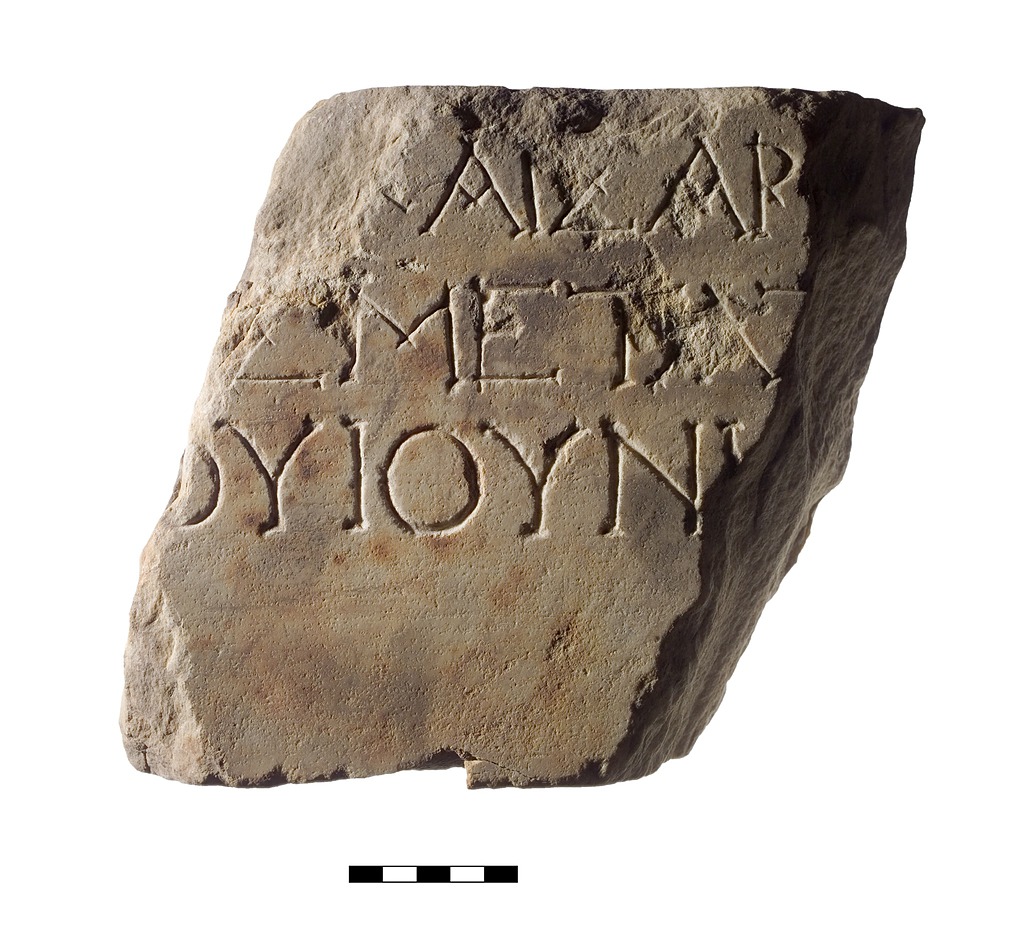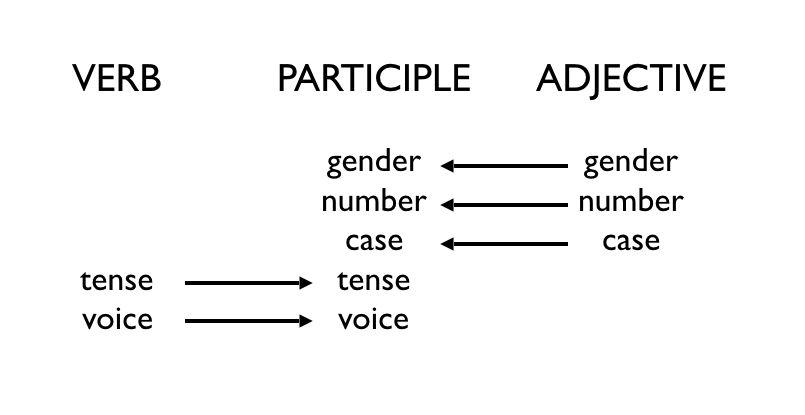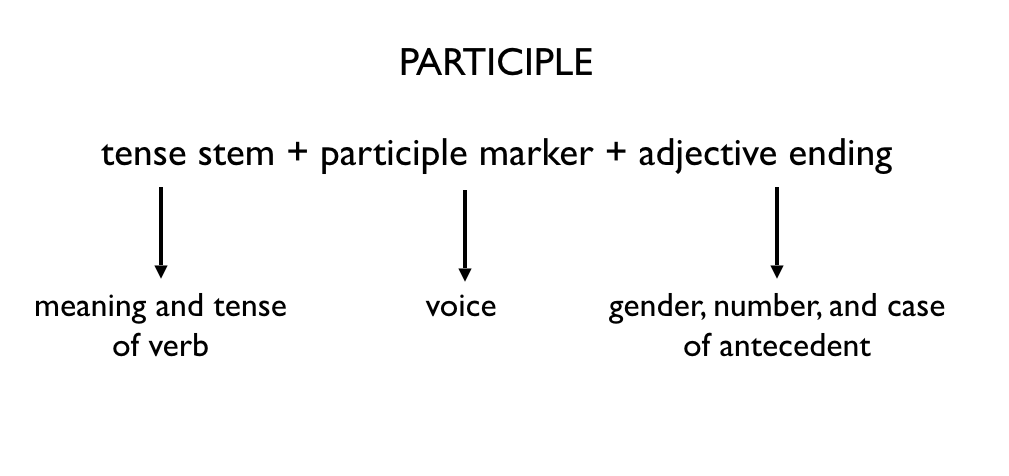37

The Participle: Introduction
This lesson presents a part of speech known as the PARTICIPLE. Essentially, participles are VERBAL ADJECTIVES. As with verbs, participles have TENSE and VOICE, and can take DIRECT or INDIRECT OBJECTS. As with adjectives, participles have GENDER, NUMBER, and CASE.
English Participles
In English, there are two participial forms:
- The PRESENT participle
- The PAST participle
The PRESENT participle in English is recognized by its ending: –ing. Sometimes the participle stands on its own; in other situations, the participle introduces a PARTICIPIAL PHRASE. A participial phrase consists of the participle, plus any other words or phrases that modify or complement the participle. The present participle in English is ACTIVE.
- Odysseus was a loving father.
- Here the participle stands on its own, modifying father.
- We see Odysseus thinking about it.
- We will see Odysseus fighting the Trojans.
- In these two sentences, each participle is modifying Odysseus; both also introduce participial phrases.
The PAST PARTICIPLE in English is most commonly identified by the ending –ed (e.g., worked, loved), though other forms exist (e.g., eaten, sung). As with the present participle, the participle can stand on its own or introduce a PARTICIPIAL PHRASE. The past participle in English is PASSIVE.
- Odysseus burned the captured city.
- Here the participle modifies city.
- The women, captured by the Greeks, are unhappy.
- Here the participle modifies women, and introduces a participial phrase.
- The war, fought mainly on the plains of Troy, will come to an end.
- Here the participle modifies war, and introduces a participial phrase.
Greek Participles
An ancient grammarian once wrote that the Greeks were φιλομέτοχοι, participle-loving. This is no exaggeration. Nearly a third (!) of Greek verbal forms are participles. As a result, mastering Greek participles is essential to reading almost any paragraph of ancient Greek.
As VERBAL ADJECTIVES, Greek participles are part VERB (and so possess tense and voice), and part ADJECTIVE (and so decline to reflect gender, number, case):
Greek participles exist in three tenses: PRESENT, FUTURE, and AORIST. To form each of these tenses:
- Participles use the same TENSE STEM that a given VERB uses in the INDICATIVE mood.
Greek participles exist in the ACTIVE, MIDDLE, and PASSIVE voices. To mark these voices:
- Participles add VOICE MARKERS to the tense stem.
Finally, Greek participles must be able to reflect the GENDER, NUMBER, and CASE of their ANTECEDENT, i.e., the noun to which the participle refers or modifies. To match the antecedent:
- Participles add ADJECTIVE endings.
Putting it all together, the formation of a participle looks something like this:
Active Participles
The pattern for ALL PARTICIPLES in the ACTIVE voice is:
- tense stem + ντ + 3-1-3 adjective endings
- A σ is added before the 1st declension endings for the FEMININE
- 1st declension endings for the FEMININE use ᾰ in the nom. and acc. sing.
- The persistent accent is on the LAST VOWEL SOUND of the TENSE STEM.
Present Active Participle: Thematic Verbs
Present active participles are built upon the PRESENT TENSE STEM. For –ω verbs, the thematic vowel ο is added before the ντ marker, producing the following pattern:
- present stem + οντ + 3-1-3 adjective endings
Predictable sound changes yield the following endings for the NOMINATIVE SINGULAR of THEMATIC PRESENT ACTIVE participles:
- Masculine: (-οντς→-ονς→) –ων
- Feminine: (-οντσα→-ονσα→) –ουσα
- Neuter: (-οντ→) –ον
On their own, these endings form one of the most common and useful participles:
Being: Present Active Participle of εἰμί be (S 305; GPH, p. 224)
Singular:
| M | F | N | |
| Nominative | ὤν | οὖσα | ὄν |
| Genitive | ὄντος | οὔσης | ὄντος |
| Dative | ὄντι | οὔσῃ | ὄντι |
| Accusative | ὄντα | οὖσαν | ὄν |
Plural:
| M | F | N | |
| Nominative | ὄντες | οὖσαι | ὄντα |
| Genitive | ὄντων | οὐσῶν | ὄντων |
| Dative | οὖσι | οὔσαις | οὖσι |
| Accusative | ὄντας | οὔσας | ὄντα |
To form the present active participle of –ω verbs, simply add the inflected forms of ων, ουσα, ον as an ending.
Loosening: Present Active Participle of λύω loosen (S 305; GPH, p. 186)
Singular:
| M | F | N | |
| Nominative | λύων | λύουσα | λῦον |
| Genitive | λύοντος | λυούσης | λύοντος |
| Dative | λύοντι | λυούσῃ | λύοντι |
| Accusative | λύοντα | λύουσαν | λῦον |
Plural:
| M | F | N | |
| Nominative | λύοντες | λύουσαι | λύοντα |
| Genitive | λυόντων | λυουσῶν | λυόντων |
| Dative | λύουσι | λυούσαις | λύουσι |
| Accusative | λύοντας | λυούσας | λύοντα |
Present Active Participle: Contract Verbs
Contract verbs follow the normal rules of contraction when forming thematic present active participles.
Grabbing: Present Active Participle of αἱρέω grab (S 310; GPH, p. 200)
Masculine:
| Nominative | (αἱρέων→) αἱρῶν |
| Genitive | (αἱρέοντος→) αἱροῦντος |
| κτλ |
Feminine:
| Nominative | (αἱρέουσα→) αἱροῦσα |
| Genitive | (αἱρεούσης→) αἱρούσης |
| κτλ |
Neuter:
| Nominative | (αἱρέον→) αἱροῦν |
| Genitive | (αἱρέοντος→) αἱροῦντος |
| κτλ |
Asking: Present Active Participle of ἐρωτάω ask (S 310; GPH, p. 198)
Masculine:
| Nominative | (ἐρωτάων→) ἐρωτῶν |
| Genitive | (ἐρωτάοντος→) ἐρωτῶντος |
| κτλ |
Feminine:
| Nominative | (ἐρωτάουσα→) ἐρωτῶσα |
| Genitive | (ἐρωταούσης→) ἐρωτώσης |
| κτλ |
Neuter:
| Nominative | (ἐρωτάον→) ἐρωτῶν |
| Genitive | (ἐρωτάοντος→) ἐρωτῶντος |
| κτλ |
Showing: Present Active Participle of δηλόω show (S 310; GPH, p. 202)
Masculine:
| Nominative | (δηλόων→) δηλῶν |
| Genitive | (δηλόοντος→) δηλοῦντος |
| κτλ |
Feminine:
| Nominative | (δηλόουσα→) δηλοῦσα |
| Genitive | (δηλοούσης→) δηλούσης |
| κτλ |
Neuter:
| Nominative | (δηλόον→) δηλοῦν |
| Genitive | (δηλόοντος→) δηλοῦντος |
| κτλ |
Present Active Participle: Athematic Verbs
For athematic (-μι) verbs, no thematic vowel is added before the ντ marker. The result is the following pattern:
- present stem + ντ + 3-1-3 adjective endings
Predictable sound changes yield the following endings for the NOMINATIVE SINGULAR of ATHEMATIC PRESENT ACTIVE participles:
- Masculine: (-ντς→-νς→) –ς
- Feminine: (-ντσα→-νσα→) –σα
- Neuter: (-ντ→) –ν
In other words, for athematic verbs, add ς, σα, ν as an ending.
Showing: Present Active Participle of δείκνυμι show (S 308; GPH, p. 216)
Singular:
| M | F | N | |
| Nominative | δεικνύς | δεικνῦσα | δεικνύν |
| Genitive | δεικνύντος | δεικνύσης | δεικνύντος |
| Dative | δεικνύντι | δεικνύσῃ | δεικνύντι |
| Accusative | δεικνύντα | δεικνῦσαν | δεικνύν |
Plural:
| M | F | N | |
| Nominative | δεικνύντες | δεικνῦσαι | δεικνύντα |
| Genitive | δεικνύντων | δεικνυσῶν | δεικνύντων |
| Dative | δεικνῦσι | δεικνύσαις | δεικνῦσι |
| Accusative | δεικνύντας | δεικνύσας | δεικνύντα |
Giving: Present Active Participle of δίδωμι give (S 307; GPH, p. 204)
| M | F | N | |
| Nominative | διδούς | διδοῦσα | διδόν |
| Genitive | διδόντος | διδούσης | διδόντος |
| κτλ |
Placing, making: Present Active Participle of τίθημι place, make (S 307; GPH, p. 212)
| M | F | N | |
| Nominative | τιθείς | τιθεῖσα | τιθέν |
| Genitive | τιθέντος | τιθείσης | τιθέντος |
| κτλ |
Standing: Present Active Participle of ἵστημι stand (S 306; GPH, p. 208)
| M | F | N | |
| Nominative | ἱστάς | ἱστᾶσα | ἱστάν |
| Genitive | ἱστάντος | ἱστάσης | ἱστάντος |
| κτλ |
Throwing: Present Active Participle of ἵημι throw (S 777)
| M | F | N | |
| Nominative | ἱείς | ἱεῖσα | ἱέν |
| Genitive | ἱέντος | ἱείσης | ἱέντος |
| κτλ |
Future Active Participle
Recall that ALL verbs are THEMATIC (-ω) verbs in the FUTURE tense. So to form the future active participle:
- Add ων, ουσα, ον to the future stem (= verb stem + σ)
About to loosen: Future Active Participle of λύω loosen (S 662; GPH, p. 188)
| M | F | N | |
| Nominative | λύσων | λύσουσα | λῦσον |
| Genitive | λύσοντος | λυσούσης | λύσοντος |
| κτλ |
About to show: Future Active Participle of δείκνυμι show (S 662)
| M | F | N | |
| Nominative | δείξων | δείξουσα | δεῖξον |
| Genitive | δείξοντος | δειξούσης | δείξοντος |
| κτλ |
– τὸ τέλος –
Paradigms, Key Terms and Concepts
- Chapter Paradigms
- PARTICIPLES AS VERBAL ADJECTIVES
- PARTICIPIAL PHRASE
- φιλομέτοχοι
- PRESENT ACTIVE PARTICIPLE OF εἰμί
- THEMATIC PRESENT ACTIVE PARTICIPLES
- ATHEMATIC PRESENT ACTIVE PARTICIPLES
- FUTURE ACTIVE PARTICIPLES
Exercises
Ι. Fill in the blank.
1. All PRESENT ACTIVE PARTICIPLES are formed according to the following pattern:
- present stem + ______+ ______ adjective endings
- ______ declension endings for the MASCULINE and NEUTER
- ______ declension endings for the FEMININE (- ______ in the nom. and acc. sing.)
2. For thematic (-ω) verbs, the thematic vowel ______ is added before the ______ marker, producing the following pattern:
- present stem + ______ + ______ adjective endings
Predictable sound changes yield the following endings for the nominative singular:
- Masculine: (-οντς→-ονς→) – ______
- Feminine: (-οντσα→-ονσα→) – ______
- Neuter: (-οντ→) – ______
3. For athematic (-μι) verbs, no thematic vowel is added before the ______ marker. Predictable sound changes yield the following endings for the nominative singular:
- Masculine: (-ντς→-νς→) –______
- Feminine: (-ντσα→-νσα→) –______
- Neuter: (-ντ→) –______
ΙΙ. For each of the following verbs, provide the NOMINATIVE and GENITIVE SINGULAR, in all genders, of the PRESENT ACTIVE PARTICIPLE.
- ποιέω
- δίδωμι
- τίθημι
- ἵστημι
- λείπω
ΙΙΙ. For each of the participial forms, identify the tense, voice, gender, number, and case. Note that there may be more than one possibility for each category.
- ὄντα
- ἀποστήσοντες
- λεγόντων
- βαίνουσαι
- οἰκοῦντας
- τιθεῖσιν
- ἀγαπῶντος
- γιγνώσκοντι
- βουλεύσοντας
- διδοῦσαν


